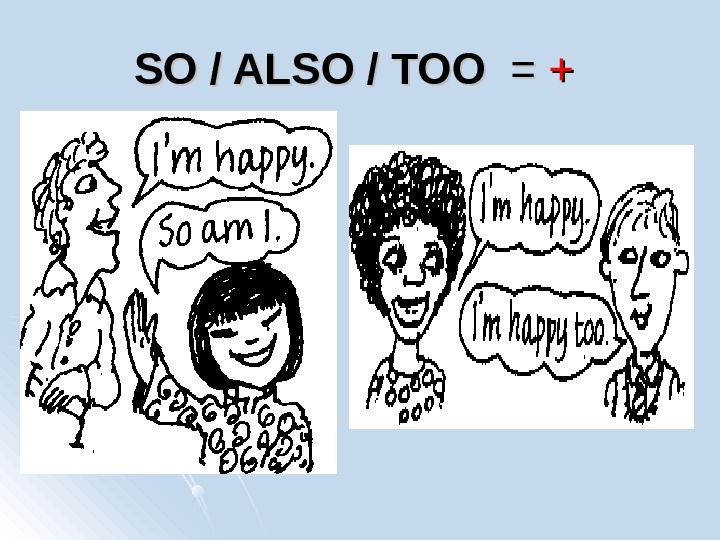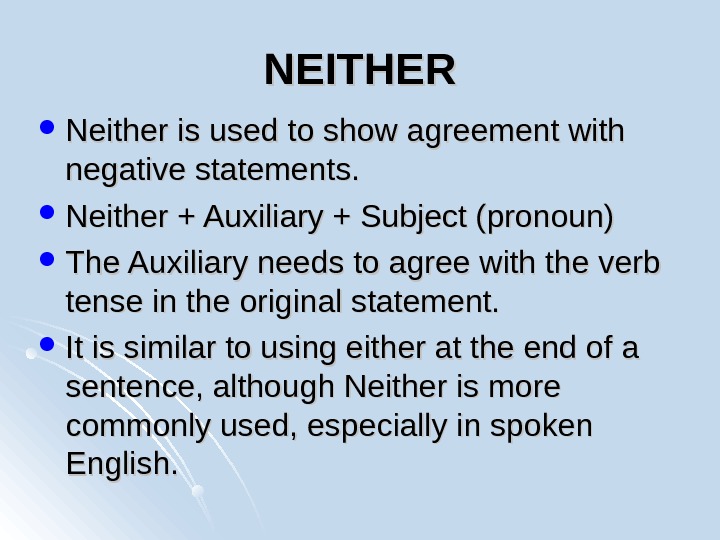SO, TOO, ALSO NEITHER , EITHER SOSO











- Размер: 307 Кб
- Количество слайдов: 11
Описание презентации SO, TOO, ALSO NEITHER , EITHER SOSO по слайдам
 SO, TOO, ALSO NEITHER , EITHER
SO, TOO, ALSO NEITHER , EITHER
 SOSO / ALSO / TOO = = ++
SOSO / ALSO / TOO = = ++
 So So amam / / dodo / / cancan / / will , etc I SOSO is used to show agreement with POSITIVE statements. SOSO + + Auxiliary + + Subject (pronoun) The Auxiliary needs to agree with the verb tense in the original statement. It is similar to using ALSO & & TOOTOO inin a a sentence
So So amam / / dodo / / cancan / / will , etc I SOSO is used to show agreement with POSITIVE statements. SOSO + + Auxiliary + + Subject (pronoun) The Auxiliary needs to agree with the verb tense in the original statement. It is similar to using ALSO & & TOOTOO inin a a sentence
 EXAMPLES: I I amam happy. So amam I. = I am happy tootoo. . = I am also happy. II ‘m’m going to Brazil. So amam I. =I am going to Brazil tootoo. . = I am also going to Brazil. You look nice today. So do you. Present Simple = You look nice tootoo. . = You also look nice. PERSON 1: PERSON 2:
EXAMPLES: I I amam happy. So amam I. = I am happy tootoo. . = I am also happy. II ‘m’m going to Brazil. So amam I. =I am going to Brazil tootoo. . = I am also going to Brazil. You look nice today. So do you. Present Simple = You look nice tootoo. . = You also look nice. PERSON 1: PERSON 2:
 EXAMPLES: We We went to the concert So diddid we. last night. Past Simple = We went to the concert tootoo. . = We also went to the concert. He He will win a prize. So will I. = I will win one tootoo. . = I will also win one. I I cancan speak 2 languages. So cancan I. = I can do that tootoo. . = I can also speak 2 languages. PERSON 1: PERSON 2:
EXAMPLES: We We went to the concert So diddid we. last night. Past Simple = We went to the concert tootoo. . = We also went to the concert. He He will win a prize. So will I. = I will win one tootoo. . = I will also win one. I I cancan speak 2 languages. So cancan I. = I can do that tootoo. . = I can also speak 2 languages. PERSON 1: PERSON 2:
 EXAMPLES: He He should study more. So should I. = I should study more tootoo. . = I should also study more. Stephanie hashas a cat. So does Mary. Present Simple = Mary has one tootoo. . Present Perfect = Mary also has a cat. They have finished So have I. their homework. = I have finished tootoo. . = I have also finished my homework. PERSON 1: PERSON 2:
EXAMPLES: He He should study more. So should I. = I should study more tootoo. . = I should also study more. Stephanie hashas a cat. So does Mary. Present Simple = Mary has one tootoo. . Present Perfect = Mary also has a cat. They have finished So have I. their homework. = I have finished tootoo. . = I have also finished my homework. PERSON 1: PERSON 2:
 NEITHER & EITHER
NEITHER & EITHER
 NEITHER Neither is used to show agreement with negative statements. Neither + Auxiliary + Subject (pronoun) The Auxiliary needs to agree with the verb tense in the original statement. It is similar to using either at the end of a sentence, although Neither is more commonly used, especially in spoken English.
NEITHER Neither is used to show agreement with negative statements. Neither + Auxiliary + Subject (pronoun) The Auxiliary needs to agree with the verb tense in the original statement. It is similar to using either at the end of a sentence, although Neither is more commonly used, especially in spoken English.
 EXAMPLES: I I don’t understand Spanish. Neither dodo I. = I don’t understand Spanish either. . II cannot swim. Neither cancan I. = I can’t swim either. . I I am not hungry. Neither amam I. = I’m not hungry either. . I = Me neither. PERSON 1: PERSON 2:
EXAMPLES: I I don’t understand Spanish. Neither dodo I. = I don’t understand Spanish either. . II cannot swim. Neither cancan I. = I can’t swim either. . I I am not hungry. Neither amam I. = I’m not hungry either. . I = Me neither. PERSON 1: PERSON 2:
 EXAMPLES: Mary didn’t go to the party. Neither diddid we. = We didn’t go either. . I I wouldn’t like to do his job. Neither would Sam. = I wouldn’t like to do it either. . He He won’t stop talking. Neither will they. = They won’t stop either. . I I haven’t passed my exams. Neither hashas Jane. = Jane hasn’t passed either. . You shouldn’t talk in the movie. Neither should you. = You shouldn’t talk either. . PERSON 1: PERSON 2:
EXAMPLES: Mary didn’t go to the party. Neither diddid we. = We didn’t go either. . I I wouldn’t like to do his job. Neither would Sam. = I wouldn’t like to do it either. . He He won’t stop talking. Neither will they. = They won’t stop either. . I I haven’t passed my exams. Neither hashas Jane. = Jane hasn’t passed either. . You shouldn’t talk in the movie. Neither should you. = You shouldn’t talk either. . PERSON 1: PERSON 2:
 We use So(So( ++ )) and Neither( — )) at the beginning of the sentence. We use too( ++ )) and either( — )) at the end of the sentence.
We use So(So( ++ )) and Neither( — )) at the beginning of the sentence. We use too( ++ )) and either( — )) at the end of the sentence.
